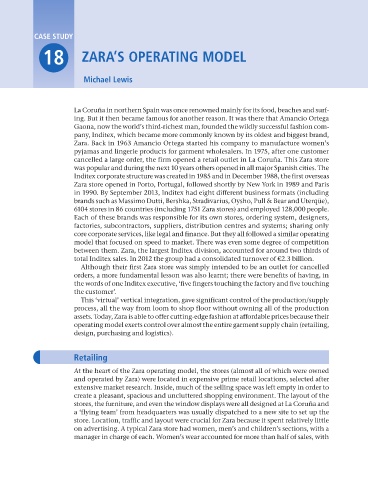Page 501 - Operations Strategy
P. 501
Case study
18 ZaRa’s opeRating model
michael lewis
La Coruña in northern Spain was once renowned mainly for its food, beaches and surf-
ing. But it then became famous for another reason. It was there that Amancio Ortega
Gaona, now the world’s third-richest man, founded the wildly successful fashion com-
pany, Inditex, which became more commonly known by its oldest and biggest brand,
Zara. Back in 1963 Amancio Ortega started his company to manufacture women’s
pyjamas and lingerie products for garment wholesalers. In 1975, after one customer
cancelled a large order, the firm opened a retail outlet in La Coruña. This Zara store
was popular and during the next 10 years others opened in all major Spanish cities. The
Inditex corporate structure was created in 1985 and in December 1988, the first overseas
Zara store opened in Porto, Portugal, followed shortly by New York in 1989 and Paris
in 1990. By September 2013, Inditex had eight different business formats (including
brands such as Massimo Dutti, Bershka, Stradivarius, Oysho, Pull & Bear and Uterqüe),
6104 stores in 86 countries (including 1751 Zara stores) and employed 128,000 people.
Each of these brands was responsible for its own stores, ordering system, designers,
factories, subcontractors, suppliers, distribution centres and systems; sharing only
core corporate services, like legal and finance. But they all followed a similar operating
model that focused on speed to market. There was even some degree of competition
between them. Zara, the largest Inditex division, accounted for around two thirds of
total Inditex sales. In 2012 the group had a consolidated turnover of €2.3 billion.
Although their first Zara store was simply intended to be an outlet for cancelled
orders, a more fundamental lesson was also learnt; there were benefits of having, in
the words of one Inditex executive, ‘five fingers touching the factory and five touching
the customer’.
This ‘virtual’ vertical integration, gave significant control of the production/supply
process, all the way from loom to shop floor without owning all of the production
assets. Today, Zara is able to offer cutting-edge fashion at affordable prices because their
operating model exerts control over almost the entire garment supply chain (retailing,
design, purchasing and logistics).
Retailing
At the heart of the Zara operating model, the stores (almost all of which were owned
and operated by Zara) were located in expensive prime retail locations, selected after
extensive market research. Inside, much of the selling space was left empty in order to
create a pleasant, spacious and uncluttered shopping environment. The layout of the
stores, the furniture, and even the window displays were all designed at La Coruña and
a ‘flying team’ from headquarters was usually dispatched to a new site to set up the
store. Location, traffic and layout were crucial for Zara because it spent relatively little
on advertising. A typical Zara store had women, men’s and children’s sections, with a
manager in charge of each. Women’s wear accounted for more than half of sales, with
Z18 Operations Strategy 62492.indd 476 02/03/2017 14:01

